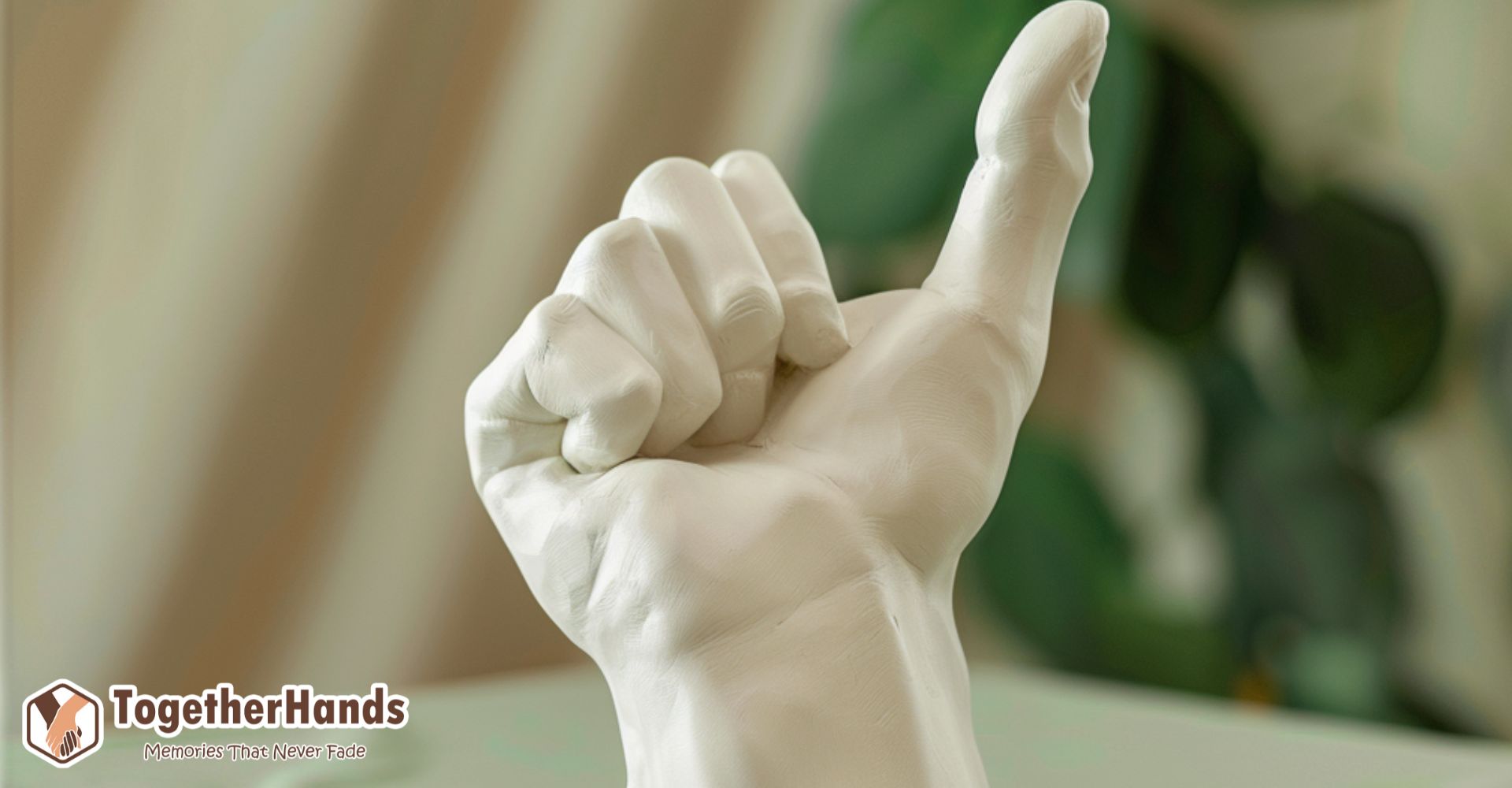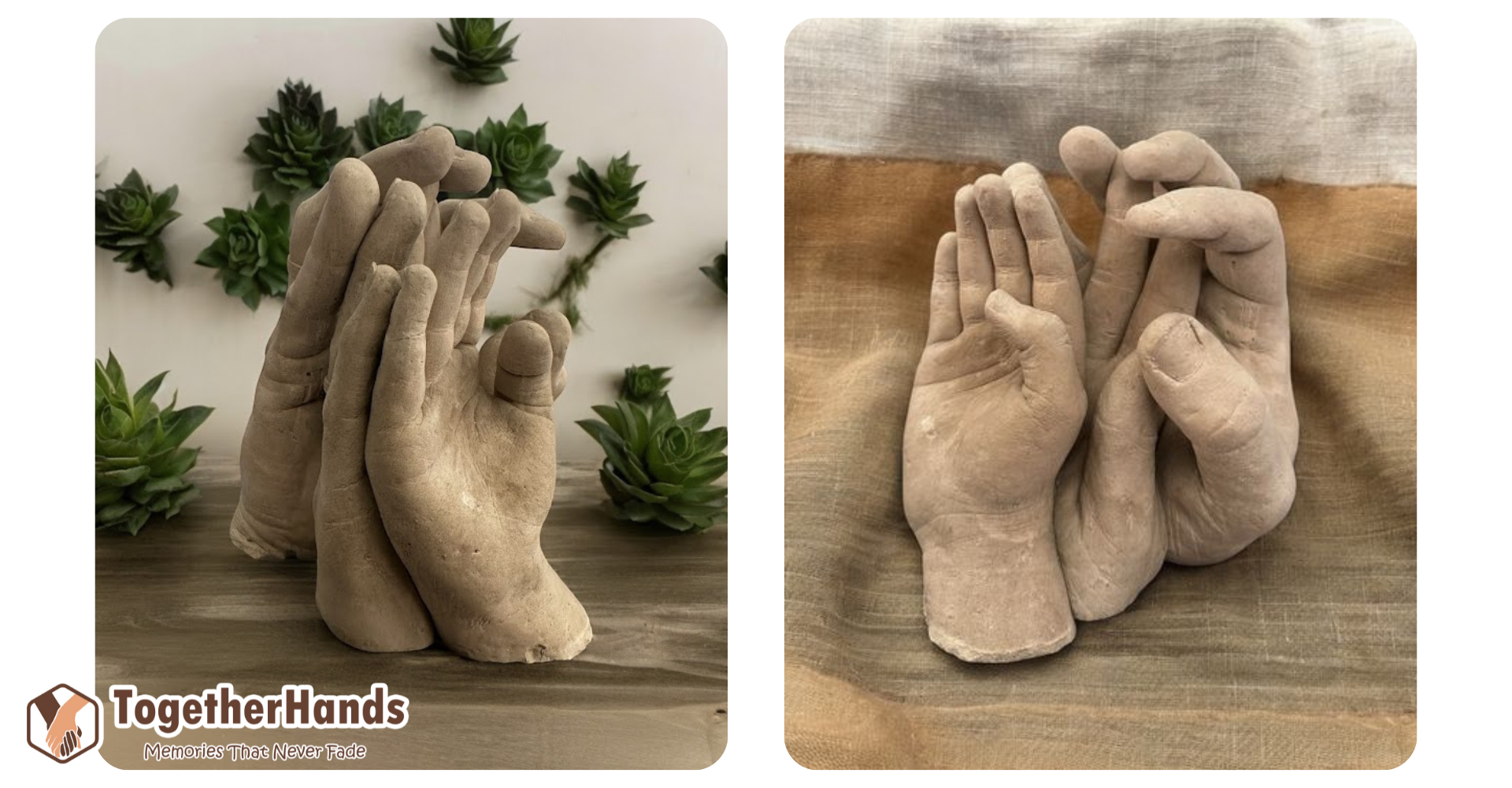
7 Pro Tips for Making Hand Sculptures
Since 2016, we have been crafting hand sculptures. We have quite a few tricks up our sleeves that we're sharing with you now to ensure that the sculptures you create are perfect and durable pieces. For example, did you know why it's important to use warm water when mixing the sampling material?
Cold or hot water?
It depends. Warm water is needed for the sampling powder, while cold water is used for the ceramic powder. Warm—or better yet, lukewarm—water is crucial for successful sampling. The water temperature should be between 26 and 30°C (79-86°F). This is extremely important because it allows the sampling material to solidify at the right time.
If the water is colder, the material sets much more slowly, requiring a longer wait. Conversely, if the water is warmer, the sampling material sets much faster, leaving you less time to properly place your hands into it.
Avoid using a blender!
You won't need a blender or food processor, just your muscles and a few minutes of steady stirring. Using a blender can introduce more bubbles into the material.
If you mix the sampling material with a blender, there's a chance that bubbles will form within the sample itself (the best-case scenario being that these bubbles protrude outward, which you can remove with sandpaper if necessary). If you attempt to mix ceramic powder with a blender, you won't have the patience—or time, since ceramic powder sets much faster than plaster—to remove bubbles from the ceramic powder material.
Do not use glass bowl!
When preparing the sampling material, it's important to select a bowl of the right size. It should not only accommodate your hands perfectly but also not be too large, as this would result in insufficient sampling powder. This can lead to hand sculptures that depict only "half" hands. Of course, if that's the effect you're aiming for, then yes, you can proceed this way.
Avoid using glass bowls because you won't be able to extract the sampling rubber (along with the ceramic) from them once it has solidified. Glass measuring cups, jam jars, larger drinking glasses, or glass mixing bowls are all unsuitable for mold removal. It would be a pity to ruin them. You definitely need a plastic bowls for this task! If you haven't purchased a suitable container with the set and don't have a large plastic soup container at hand, a plastic pickle jar can also serve the purpose.
Long artificial nails? Here's how to handle them!
You can achieve beautiful results even with long artificial nails, but pay attention to a few details! Despite the high quality of the ceramic powder, long, thin protruding elements can be fragile as you remove them from the mold. If you want to avoid the risk of immortalizing broken nails, when creating a hand sculpture, bend your fingers so that they conform to your partner's hand and don't stick out.
Here's an additional tip: Gel nails and grown-out nail polish will also be visible! Additionally, the shape of the nail sticker will show through. Consider these factors when preparing the manicure for your hand sculpture. For men, it's best if nails are not cut too short; the most aesthetically pleasing results are achieved with nails grown out to 2-3 millimeters.
Secrets of the perfect baby hand or foot statuette
It might seem straightforward, but it's not as easy as it looks. You can't explain to a baby why you're immersing their little hands or feet in something and expecting them not to pull away. If they get scared, not only will the shape not turn out well, but it could also create a negative memory. So, if you're creating a unique sculpture with a baby, here are some tips to keep in mind:
- Ensure the baby is awake, calm, and content.
- Engage them continuously with talk, storytelling, or singing.
- Use water at the right temperature specifically for the sampling powder.
- Don't attempt this alone; you'll need at least 4 hands for this task.
- Practice beforehand: Dip the baby's hands or feet in lukewarm water and hold them there for a few minutes before attempting the actual sampling.

Those pesky air bubbles
If you're aiming for a perfect hand sculpture, you definitely don't want any unwanted "dots" marring your detailed masterpiece. These dots are caused by air bubbles. When you mix fast-setting ceramic powder, it's inevitable that air gets mixed in, similar to working with plaster.
If you've ever cast plaster figures as a child, you might recognize the sight. To prevent this, you need to take steps to eliminate air bubbles before the mixture dries. The larger and more intricate the mold (like a family hand sculpture), the higher the likelihood of air bubbles.
Here are the key steps to follow:
- Slowly drip the ceramic powder mixture into the mold in small amounts.
- Carefully rotate the mold to ensure the mixture fills every intricate detail.
- After pouring each small amount, gently shake or tap the mold on the edge of a table. Avoid vigorous shaking; handle it with care and delicacy.
- How much is a small amount? It varies depending on the mold, but aim for at least 4-5 portions. Also, be mindful not to work too slowly, as ceramic powder sets quickly! If it begins to harden before you add the next portion, streaks may appear.
- Once the mold is completely filled, gently shake it for a brief period. If you notice bubbles forming on the surface of the ceramic powder mixture, congratulations! Those bubbles won't appear on your final creation.
Following these steps diligently will help you achieve a flawless hand sculpture without unsightly air bubbles.
Can a paw sculpture be made from a pet's paw?
Yes, it's possible to create a paw sculpture from your pet's paw if they are patient enough to participate. The sampling material may adhere to their fur somewhat, but you can easily rinse it off with cold water afterward. If your pet tends to get nervous, achieving the perfect pattern can be a bit challenging.
Here are some tips to help you:
- Secure Grip: Hold your pet's paw firmly.
- Positioning: Ideally, place your dog's paw in your hand with the pads facing outward.
- Pressing: Gently press the paw into the sampling material to achieve better results.
- Caution with Cats: Cats and other pets prone to biting or scratching may pose additional challenges. Test their tolerance by first seeing if they allow their feet to be dipped in water for a few minutes before attempting the sculpture.
Important Note: Ensure your pet's paw is clean and free from dust before taking the sample to ensure the best outcome.
Taking these precautions will help you create a meaningful and accurate paw sculpture of your beloved pet.


